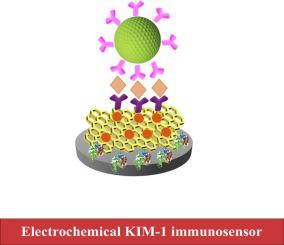Applied Surface Science ( IF 6.3 ) Pub Date : 2021-12-01 , DOI: 10.1016/j.apsusc.2021.152093 Havva Boyacıoğlu 1 , Bahar Bankoğlu Yola 2 , Ceren Karaman 3 , Onur Karaman 4 , Necip Atar 1 , Mehmet Lütfi Yola 5

|
Acute kidney injury is among the most severe health problems today, with the greatest fatality ratios. The kidney injury molecule-1 (KIM-1) is considered to be a potential biomarker for diagnosis of the acute kidney injury. Herein, a sensitive, selective, and swift sandwich-type electrochemical KIM-1 immunosensor was fabricated based on porous NiCo2S4@CeO2 microspheres as a signal amplifier and covalent organic frameworks-gold nanoparticles (COFs-AuNPs) composite as an electrochemical sensor platform. The affinity of amino-gold between capture antibody and COFs-AuNPs composite led to immobilization of the capture antibody. The secondary antibody was then conjugated to NiCo2S4@CeO2 microspheres via electrostatic interactions. Transmission electron microscopy (TEM), scanning electron microscopy (SEM), fourier-transform infrared spectroscopy (FTIR), x-ray diffraction (XRD) and x-ray photoelectron spectroscopy (XPS) techniques were performed to characterize the as-prepared materials. Some electrochemical characterization techniques including cyclic voltammetry (CV), electrochemical impedance spectroscopy (EIS) and differential pulse voltammetry (DPV) were employed to gradually characterize the constructed immunosensor. The detection limit (LOD) of KIM-1 in plasma samples was calculated as 2.00 fg mL−1, making it an effective tool for the monitoring of acute kidney injury.
中文翻译:

基于共价有机骨架的新型电化学肾损伤分子-1 (KIM-1) 免疫传感器-金纳米颗粒复合材料和多孔 NiCo2S4@CeO2 微球:急性肾损伤的监测
急性肾损伤是当今最严重的健康问题之一,死亡率最高。肾损伤分子-1 (KIM-1) 被认为是诊断急性肾损伤的潜在生物标志物。在本文中,一个敏感的,选择性的和迅速的夹心型电化学KIM-1免疫制作基于多孔镍钴2小号4 @CeO 2个微球作为信号放大器和共价有机骨架-金纳米颗粒(COF的-的AuNP)复合物作为电化学传感器平台。捕获抗体和 COFs-AuNPs 复合物之间氨基-金的亲和力导致捕获抗体的固定。然后将二抗偶联至NiCo 2 S 4 @CeO 2通过静电相互作用形成微球。使用透射电子显微镜 (TEM)、扫描电子显微镜 (SEM)、傅里叶变换红外光谱 (FTIR)、X 射线衍射 (XRD) 和 X 射线光电子能谱 (XPS) 技术来表征所制备的材料。采用循环伏安法(CV)、电化学阻抗谱(EIS)和差分脉冲伏安法(DPV)等电化学表征技术逐步表征构建的免疫传感器。血浆样品中 KIM-1 的检测限 (LOD) 计算为 2.00 fg mL -1,使其成为监测急性肾损伤的有效工具。











































 京公网安备 11010802027423号
京公网安备 11010802027423号